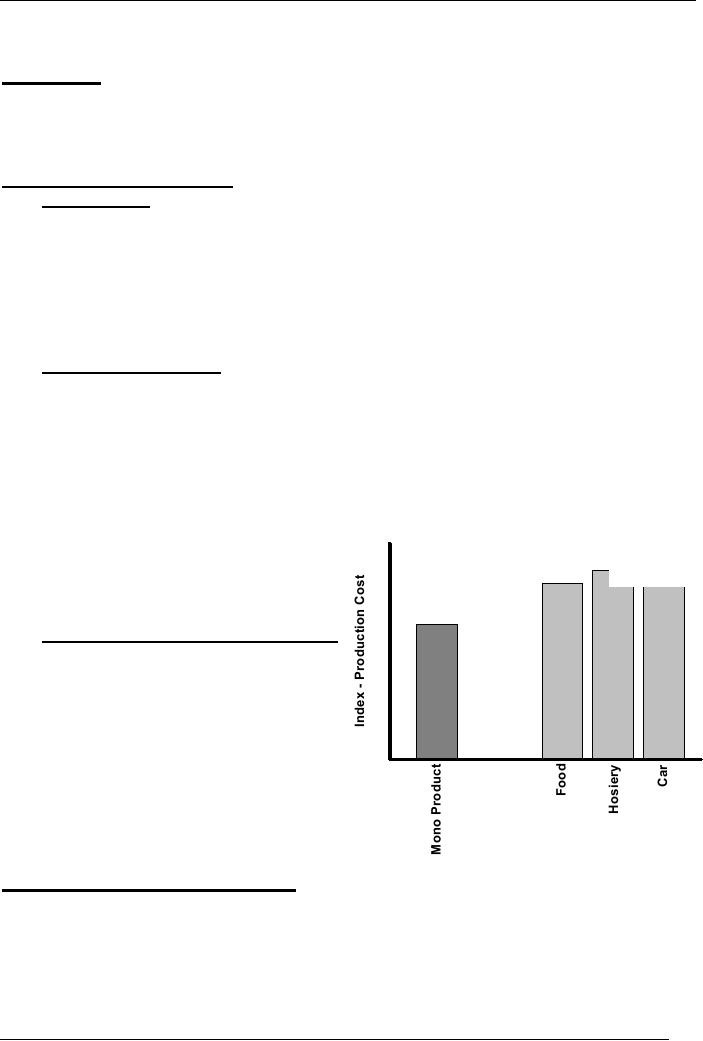 |

Brand
Management (MKT624)
VU
Lesson
22
LINE
EXTENSION
Introduction
The
discussion in this lecture
moves on to the negative
sides of extension. Having
known those
we
shall be in a better position to
realistically manage extensions and
that precisely is going
to
be
an important part of this
lecture.
Negative
side of line
extension
1.
Retailer power
When
all managers like to extend
with similar objectives, the
obvious results are
bottlenecks
at the retail level. This
clutter leads to selective
attitude on part of
retailers
who
obviously are more receptive
toward more powerful brands.
Those that get
discriminated
try to react by getting into
promotions, thereby making
retailers and
consumers
happy at the same time.
What ensues is obviously the
price wars and
erosion
of
brand loyalty. Not good for
the brand!
2.
Lack of scale economies
As
against a mono product, handling and
managing a variety of products is
cumbersome
from
production, logistics, inventory, and
costing points of view.
Smaller runs deprive
the
company
of scale economies. They are
more expensive. According to one
study,
compared
with an index of 100 as the cost of
production for a mono
product, the
corresponding
cost
index
for
Cost
Index Mono vs.
Differentiated Products
differentiated
products is shown on
the
diagram1.
Economies
of scale take on added
importance
if the brand sells in
high
Figure
26
volumes
across a huge geographic
area
positioned
on consumer friendly
pricing.
3.
Non-controlled extension weakens
range
Extensions
without strong rationale
can
145
135
become
counter-productive,
because
132
creating
meaningful positioning for
a
100
variety
of products within the same
line
becomes
challenging. All positions
have
to
be created with subtle yet
distinct
differences.
Without
meaningful
differences,
products tend to eat
into
each
other's volume and
cause
cannibalization!
Reaction
to negative side of
extensions
There
has been lately a tendency
on part of the companies to de-segment or
counter-segment
their
markets. Proctor and Gamble reduced
their line by about 15 to 25
percent in 1992 only
because
those entries were not
turning in requisite volumes and
profitability1.
It also leads to
consumer
frustration and that's what we
learnt in terms of consumer
revolt. The factor of
scale
economies
takes a turn for better
under the circumstances of
de-segmentation. Lesser
number
of
offerings leads to higher
volumes, which result in
lower costs of
producing.
86

Brand
Management (MKT624)
VU
Immediate
actions for better managing
line extensions
1.
Improve cost accounting systems
Management
experts lay a lot of
emphasis on improving cost accounting
systems.
Experience
shows that many companies
are system-deficient in this regard. You
must
have
accurate figures to charge every range
item that you produce.
The objective is to
determine
which items are more
profitable than
others.
2.
Allocate resources more to
high-margin items
As
brand managers and good businesspeople,
you must allocate marketing
resources to
different
items in line with their
contribution to the overall
profitability. The
extensions
that
give higher margins must get
priority over those that
attract occasional
buyers.
3.
Salespeople must define the
role of each
extension
Each
extension has to be seen in
the context of its sales
value. The
salespersons
responsible
for each must produce
figurative evidence of what
they sell is worth
its
existence.
Salespeople must understand
the costing angle and then
produce results out
of
the
extensions that account for
most of the profitable
business.
They
must be able to relate profitability
with high volume items.
Their education as
part
of
AUDIENCE is of significance, for
mostly salespeople go after
volumes no matter how
high
is the cost. They must
understand the actual
positioning of the product
along with the
strategic
goals of financial growth. Volumes
just for the sake of a
high market share
with
low
profitability may not be the
company's priority at all
times.
Small
volumes adding up to a certain
total volume cost a lot more
than the same
total
arrived
at by less number of products.
Economies!
4.
Encourage product
withdrawal
Implement
this philosophy and withdraw
low volume items in a phased
way so that your
existing
customers do not turn away
to competition; they should
rather switch over to
another
attractive offering within
your range.
Bibliography:
1.
Jean-Noel Kapferer: "Strategic Brand
Management Creating and
Sustaining
Brand
Equity Long Term"; Kogan
Page (184)
Suggested
readings:
1.
Jean-Noel Kapferer: "Strategic Brand
Management Creating and
Sustaining
Brand
Equity Long Term"; Kogan
Page (181-186)
87
Table of Contents:
- UNDERSTANDING BRANDS – INTRODUCTION:Functions of Brand Management, Sales forecast, Brand plan
- INTRODUCTION:Brand Value and Power, Generate Profits and Build Brand Equity
- BRAND MANIFESTATIONS/ FUNDAMENTALS:Brand identity, Communication, Differentiation
- BRAND MANIFESTATIONS/ FUNDAMENTALS:Layers/levels of brands, Commitment of top management
- BRAND CHALLENGES:Consumer Revolt, Media Cost and Fragmentation, Vision
- STRATEGIC BRAND MANAGEMENT:Setting Objectives, Crafting a Strategy, The Brand Mission
- BRAND VISION:Consensus among management, Vision Statement of a Fast Food Company, Glossary of terms
- BUILDING BRAND VISION:Seek senior management’s input, Determine the financial contribution gap
- BUILDING BRAND VISION:Collect industry data and create a brand vision starter, BRAND PICTURE,
- BRAND PICTURE:Brand Value Pyramid, Importance of being at pinnacle, From pinnacle to bottom
- BRAND PERSONA:Need-based segmentation research, Personality traits through research
- BRAND CONTRACT:The need to stay contemporary, Summary
- BRAND CONTRACT:How to create a brand contract?, Brand contract principles, Understand customers’ perspective
- BRAND CONTRACT:Translate into standards, Fulfill Good Promises, Uncover Bad Promises
- BRAND BASED CUSTOMER MODEL:Identify your competitors, Compare your brand with competition
- BRAND BASED CUSTOMER MODEL:POSITIONING, Product era, Image Era, An important factor
- POSITIONING:Strong Positioning, Understanding of components through an example
- POSITIONING:Clarity about target market, Clarity about point of difference
- POSITIONING – GUIDING PRINCIPLES:Uniqueness, Credibility, Fit
- POSITIONING – GUIDING PRINCIPLES:Communicating the actual positioning, Evaluation criteria, Coining the message
- BRAND EXTENSION:Leveraging, Leveraging, Line Extension in detail, Positive side of line extension
- LINE EXTENSION:Reaction to negative side of extensions, Immediate actions for better managing line extensions
- BRAND EXTENSION/ DIVERSIFICATION:Why extend/diversify the brand,
- POSITIONING – THE BASE OF EXTENSION:Extending your target market, Consistency with brand vision
- DEVELOPING THE MODEL OF BRAND EXTENSION:Limitations, Multi-brand portfolio, The question of portfolio size
- BRAND PORTFOLIO:Segment variance, Constraints, Developing the model – multi-brand portfolio
- BRAND ARCHITECTURE:Branding strategies, Drawbacks of the product brand strategy, The umbrella brand strategy
- BRAND ARCHITECTURE:Source brand strategy, Endorsing brand strategy, What strategy to choose?
- CHANNELS OF DISTRIBUTION:Components of channel performance, Value thru product benefits
- CREATING VALUE:Value thru cost-efficiency, Members’ relationship with brand, Power defined
- CO BRANDING:Bundling, Forms of communications, Advertising and Promotions
- CUSTOMER RESPONSE HIERARCHY:Brand-based strategy, Methods of appropriations
- ADVERTISING:Developing advertising, Major responsibilities
- ADVERTISING:Message Frequency and Customer Awareness, Message Reinforcement
- SALES PROMOTIONS:Involvement of sales staff, Effects of promotions, Duration should be short
- OTHER COMMUNICATION TOOLS:Public relations, Event marketing, Foundations of one-to-one relationship
- PRICING:Strong umbrella lets you charge premium, Factors that drive loyalty
- PRICING:Market-based pricing, Cost-based pricing
- RETURN ON BRAND INVESTMENT – ROBI:Brand dynamics, On the relevance dimension
- BRAND DYNAMICS:On the dimension of knowledge, The importance of measures
- BRAND – BASED ORGANIZATION:Benefits, Not just marketing but whole culture, Tools to effective communication
- SERVICE BRANDS:The difference, Hard side of service selling, Solutions
- BRAND PLANNING:Corporate strategy and brands, Brand chartering, Brand planning process
- BRAND PLANNING PROCESS:Driver for change (continued), Brand analysis
- BRAND PLAN:Objectives, Need, Source of volume, Media strategy, Management strategy